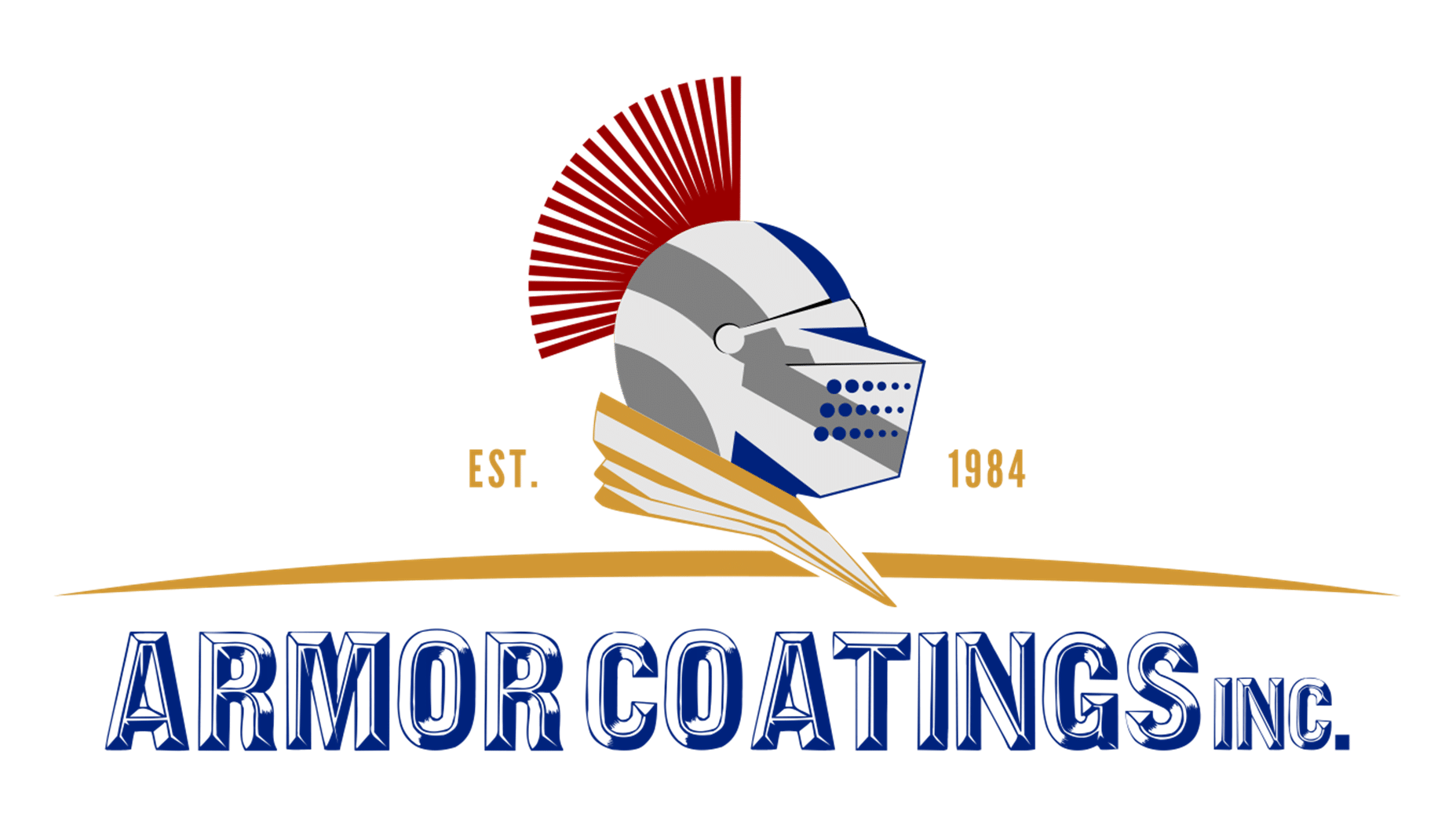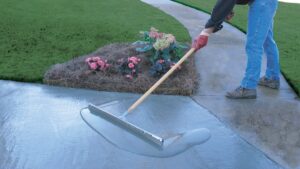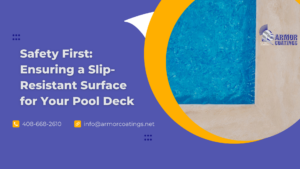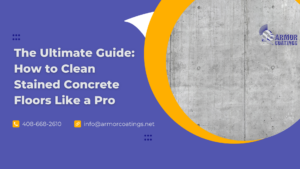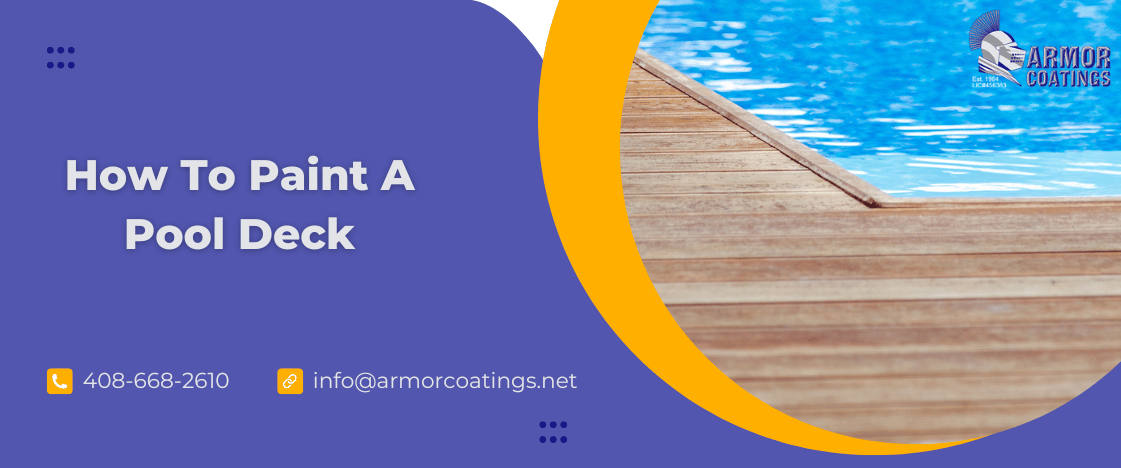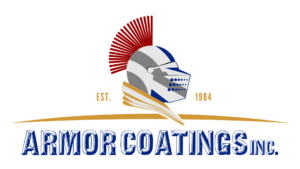A swimming pool is a wonderful addition to any home or community, offering a place for relaxation, exercise, and social gatherings. However, with the joy and benefits that a pool brings, it is crucial to address the safety aspects, particularly the pool deck area. Wet surfaces combined with the excitement often associated with pool activities can create a recipe for slips and falls. This is where the importance of having a slip-resistant surface for your pool deck comes into play.
Slip-resistant surfaces not only minimize the risk of accidents but also contribute to the overall experience of using the pool area. Whether it’s children playing, adults socializing, or seniors taking a leisurely swim, a slip-resistant pool deck ensures that all age groups can enjoy the pool safely.
In this article, we will delve into the significance of slip-resistant surfaces, explore various options for making your pool deck slip-resistant, and share best practices for maintaining these surfaces. Whether you are a homeowner, a community pool manager, or someone considering adding a pool to your property, this article will equip you with the knowledge and insights needed to make informed decisions regarding pool deck safety.
Understanding Slip Hazards
Pool decks are naturally prone to becoming wet due to splashing water, and this moisture can make the surface slippery. Here are some common causes of slips and falls on pool decks:
- Excess Water: Constant splashing and accumulation of water can make the surface very slick.
- Algae Growth: The combination of water and sunlight can lead to algae growth, which is extremely slippery.
- Lack of Textured Surface: Smooth surfaces without any texture can contribute to slips.
- Spills: Spilled drinks or other liquids can create slippery spots.
- Inappropriate Footwear: Wearing non-aquatic shoes or running barefoot can increase the risk of slipping.
Statistics on Pool Deck Accidents
Understanding the statistics related to pool deck accidents can highlight the gravity of the issue:
- Frequency of Accidents: According to the Centers for Disease Control and Prevention (CDC), over 200,000 people are injured in swimming pool-related accidents annually, and a significant portion of these accidents are due to slips and falls.
- Age Groups Affected: While all age groups are susceptible, children and the elderly are particularly at risk.
- Consequences: Injuries can range from minor bruises to more severe cases like fractures, head injuries, or even fatalities.
The Role of Surface Material in Slip Resistance
The material of the pool deck plays a significant role in its slip resistance:
- Porous vs. Non-Porous Materials: Porous materials like certain types of natural stone can absorb some water, reducing the slipperiness. In contrast, non-porous materials like tiles can become very slippery when wet.
- Textured Surfaces: Materials with a textured surface provide more grip compared to smooth surfaces.
- Chemical Treatments: Some materials can be treated with chemicals to enhance their slip-resistant properties.
Understanding these slip hazards is the first step in creating a safer environment around the pool area. The next sections will explore how to mitigate these risks through slip-resistant surfaces and maintenance practices.
The Importance of Slip-Resistant Surfaces
Enhancing Safety for All Age Groups
- Children: Children are often the most active around the pool area. A slip-resistant surface can significantly reduce the risk of slips and falls, preventing injuries.
- Adults: For adults, especially those who exercise or engage in water sports, slip-resistant surfaces can provide the necessary grip to move confidently.
- Seniors: As seniors are more prone to slips and falls, having a slip-resistant surface is crucial for their safety.
Reducing Liability and Insurance Costs
- Legal Liability: Property owners and managers could face legal liability for accidents that occur due to negligence in maintaining a safe environment. Slip-resistant surfaces are an essential aspect of this.
- Insurance: Implementing safety measures such as slip-resistant surfaces can potentially lower insurance premiums as it reduces the risk of accidents.
Improving the Overall Experience of Using the Pool Area
- Peace of Mind: Knowing that the pool deck is slip-resistant can provide peace of mind for both the property owners and the users.
- Enhanced Enjoyment: A safer environment means that individuals can focus on enjoying their time without being overly cautious about slipping.
- Aesthetic Appeal: Modern slip-resistant surfaces come in various designs and materials, which can enhance the aesthetic appeal of the pool area.
In summary, slip-resistant surfaces are not just a safety feature but an investment in the well-being of all who use the pool. They play a vital role in enhancing safety, reducing legal and financial liabilities, and improving the overall experience of the pool area. The next section will explore the various options available for slip-resistant pool deck surfaces.
Options for Slip-Resistant Pool Deck Surfaces
Textured Concrete
- Description: Textured concrete involves imprinting patterns on the concrete surface to create a textured finish.
- Benefits: It provides a natural grip, is durable, and requires low maintenance.
- Considerations: Variety of patterns available; can be combined with color to enhance aesthetics.
Pavers with Natural Grip
- Description: Pavers are individual pieces made from materials like stone or concrete, and some come with a natural, rough texture.
- Benefits: They are slip-resistant, easy to replace if damaged, and allow for creative designs.
- Considerations: Installation may be more time-consuming; regular maintenance is needed to prevent weed growth between pavers.
Rubberized Coatings
- Description: Rubberized coatings are made from recycled rubber and can be applied over existing surfaces.
- Benefits: They are slip-resistant, comfortable underfoot, and available in various colors.
- Considerations: They may be less durable than other options and can require more frequent maintenance.
Epoxy Coatings with Anti-Slip Additives
- Description: Epoxy coatings are resin-based coatings that can be mixed with anti-slip additives like sand or grit.
- Benefits: They create a durable, waterproof, and slip-resistant surface.
- Considerations: They require professional installation and periodic re-coating.
Brushed or Broom Finish
- Description: This involves dragging a broom across wet concrete to create a textured surface.
- Benefits: It’s a simple and cost-effective way to add slip-resistance to concrete.
- Considerations: It’s less decorative than other options but can be combined with colored concrete.
Tiles with Anti-Slip Finish
- Description: Specialized tiles designed with an anti-slip finish.
- Benefits: They come in various designs and are easy to clean.
- Considerations: They can be more expensive and require professional installation.
Comparison of Options in Terms of Cost, Maintenance, and Effectiveness
- Textured Concrete: Cost-effective, durable, low maintenance.
- Pavers with Natural Grip: Moderate cost, high maintenance, highly effective.
- Rubberized Coatings: Moderate cost, moderate maintenance, highly effective.
- Epoxy Coatings with Anti-Slip Additives: Higher cost, low maintenance, highly effective.
- Brushed or Broom Finish: Low cost, low maintenance, moderately effective.
- Tiles with Anti-Slip Finish: Higher cost, low maintenance, highly effective.
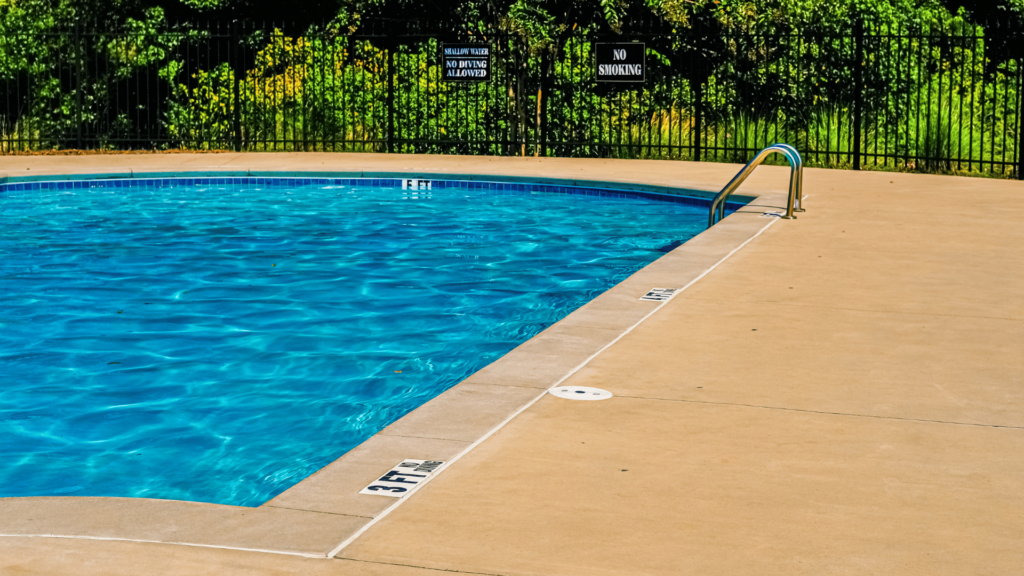
Best Practices for Maintaining Slip-Resistance
Regular Cleaning and Maintenance
- Importance: Regular cleaning is essential to maintain the slip-resistant properties of the pool deck surface.
- Methods: Use a broom, hose, or pressure washer to remove dirt, leaves, and other debris. Clean spills immediately.
- Cleaning Agents: Use cleaning agents that are specifically designed for the type of surface material to avoid damage or reduction in slip-resistance.
Monitoring for Wear and Tear
- Importance: Over time, the surface can wear down, reducing its slip-resistant properties.
- Inspection: Regularly inspect the surface for signs of wear, such as smooth areas, cracks, or loosening material.
- Repairs: Promptly repair any damage to the surface to maintain its slip-resistant properties.
Seasonal Considerations and Care
- Winter Care: In colder climates, protect the surface from freeze-thaw cycles by sealing it before winter and shoveling snow carefully to avoid damage.
- Summer Care: In hot climates, regular cleaning is essential as the combination of heat and moisture can lead to algae growth, which is slippery.
When to Seek Professional Assessment and Resurfacing
- Assessment: If you notice significant wear or if the surface is several years old, it’s wise to have a professional assess its condition.
- Resurfacing: Depending on the assessment, it may be necessary to resurface the pool deck to restore its slip-resistant properties.
Additional Safety Measures
Proper Drainage to Prevent Water Pooling
- Importance: Proper drainage prevents water from pooling on the surface, which can create slip hazards.
- Solutions: Install drains and ensure that the pool deck is sloped appropriately to direct water away from the pool area.
Use of Pool Deck Furniture to Minimize Running and Risky Behavior
- Importance: Strategically placed furniture can discourage running and create designated areas for different activities.
- Tips: Place lounge chairs and tables around the perimeter, and create designated areas for eating, sunbathing, and watching swimmers.
Clear Signage and Rules for Pool Deck Conduct
- Importance: Clear rules and signage can educate pool users on safe behavior.
- Examples of Signage: “No Running,” “Wet Surface,” “No Diving in Shallow End,” etc.
Training and Education for Family Members or Pool Users
- Importance: Educating pool users on safe behavior can prevent accidents.
- Methods: Hold safety briefings, provide written materials, or post educational content online.
Non-Slip Footwear
- Importance: Encouraging the use of non-slip footwear can add an extra layer of slip resistance.
- Tips: Provide information on where to purchase non-slip footwear and consider keeping a few pairs available for guests.
Regular Safety Audits
- Importance: Regular safety audits can help identify potential hazards before they cause accidents.
- Methods: Conduct self-audits or hire a professional to assess the pool area for safety compliance.
Emergency Preparedness
- Importance: Being prepared for emergencies can minimize injuries if an accident does occur.
- Methods: Keep a first-aid kit nearby, know the location of the nearest phone, and be familiar with basic first-aid procedures.
By implementing these additional safety measures alongside a slip-resistant surface, you can create a comprehensive safety plan for your pool deck. This not only minimizes the risk of accidents but also contributes to a more enjoyable and worry-free experience for all pool users. In the next section, we will look at a case study that demonstrates the successful implementation of a slip-resistant pool deck.
Paving the Way to a Safer Pool Experience with Slip-Resistant Surfaces
As we have explored throughout this article, ensuring a slip-resistant surface for your pool deck is paramount in creating a safe and enjoyable environment for all. From understanding the slip hazards to exploring various slip-resistant options and best practices for maintenance, it is evident that a well-thought-out approach to pool deck safety can significantly reduce the risk of accidents and enhance the overall pool experience.
Moreover, additional safety measures such as proper drainage, clear signage, and regular safety audits complement the slip-resistant surfaces in forming a comprehensive safety plan.
Now, it’s time to take action. Whether you are considering resurfacing your pool deck or looking for ways to improve its safety, Armor Coatings is here to assist you. With years of experience and expertise in concrete resurfacing and safety solutions, Armor Coatings can help you transform your pool deck into a safe and aesthetically pleasing space.
Call to Action: Take the First Step Towards a Safer Pool Deck with Armor Coatings
Don’t wait for an accident to happen. Take a proactive approach to pool deck safety. Contact Armor Coatings today for a professional assessment of your pool deck and explore the range of slip-resistant solutions tailored to your needs. Let Armor Coatings be your partner in paving the way to a safer and more enjoyable pool experience for everyone.
Contact Armor Coatings Now to Get Started!
